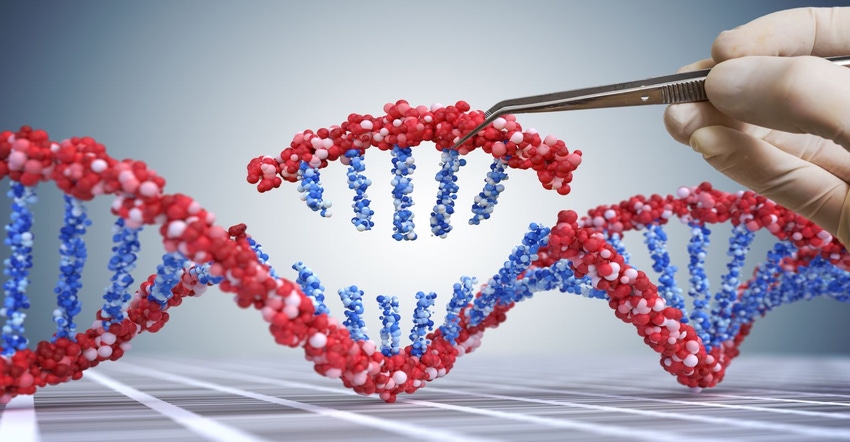Ag industry, consumer advocates split over USDA animal biotech proposal
A turf war is likely to persist between USDA and FDA over which agency is better suited to regulate genetically engineered animals.

On Jan. 19, the leaders of two U.S. government agencies provided starkly different perspectives about a memorandum of understanding (MOU) regarding regulation of agricultural animal biotechnology.
The MOU “clears a path to bring our regulatory framework into the 21st century, putting American producers on a level playing field with their competitors around the world,” then-outgoing Agriculture Secretary Sonny Perdue said in a statement. “In the past, regulations stifled innovation, causing American businesses to play catch-up and cede market share.”
The MOU was finalized with FDA, outlining responsibilities regarding the regulation of certain animals developed using genetic engineering intended for agricultural purposes including human food, according to USDA.
FDA opposition
The document clearly didn’t sit well with the then-top official at FDA, Dr. Stephen Hahn, who tweeted on Jan. 19 that while the U.S. Department of Health and Human Services (HHS)—of which FDA is a part—signed the MOU with USDA, his agency did not support it.
“FDA has no intention of abdicating our public health mandate,” Hahn proclaimed on Twitter a day before he departed the agency, coinciding with the inauguration of President Joe Biden. “We’ll continue to stay focused on executing our vital public health mission entrusted to us by the American people.”
The MOU was signed by Perdue and Brett Giroir, M.D., assistant secretary for Health and head of the Public Health Service. Due to the change in administration, the top officials mentioned in this story—Hahn, Giroir and Perdue—have moved on from their posts in the U.S. government.
But a turf war is likely to persist between USDA and FDA over which agency is better suited to regulate genetically engineered animals.
FDA career lawyers had objected to the MOU, Politico reported in a Jan. 19 article, citing “people with knowledge of the discussions.” And Hahn in recent days refused to sign off on the MOU, a senior HHS official told Politico.
“This is a last-minute Hail Mary,” the story quoted the senior HHS official. “It is a total ceding of FDA authority to the USDA.”
Shifting authority to USDA
Largely at stake: the regulation of agricultural animals like cattle and swine subject to gene editing—otherwise known as genome editing. These technologies function “like scissors, cutting the DNA at a specific spot,” which enable scientists to add, remove or replace DNA where it was cut, according to the National Human Genome Research Institute.
The recently signed MOU paves the way for USDA to use its authorities under two laws�—the Federal Meat Inspection Act and Poultry Products Inspection Act—to create a new program through rulemaking to oversee pre-market human food safety evaluations and monitoring for agricultural animals using genetic engineering. Per the MOU, FDA would continue to use its authority under a separate law—the Federal Food, Drug & Cosmetic Act (FDCA)—to regulate certain things, including table and shell eggs, certain meat products and animal feed that originates from agricultural animals developed using genetic engineering.
The four-page document, as well as a previous advanced notice of proposed rulemaking (ANPR) announced by USDA in December, was interpreted as shifting much authority over regulation of certain genetically engineered animals from FDA to USDA.
But it wasn’t immediately clear how USDA under a new administration would approach the issues. The Biden administration recently imposed a freeze on certain pending regulatory actions.
Asked whether policies implemented by the new Biden administration affect either the MOU or ANPR, a spokesperson for USDA responded the ANPR “is under review.”
As of Jan. 27, the document had drawn 17 comments on the public docket (regulations.gov), including two separate submissions from a Florida resident named Dorian Atchison. “This is outrageous that GM animals and other GM products could be pushed through without independent oversight, and plenty of time for public input,” she wrote.
Urging USDA “not to approve eliminating FDA oversight,” Atchison stated, “We need as much oversight in this area as is possible.”
The ANPR was announced more than a year after then-President Trump signed an executive order on agricultural biotechnology products.
“Biotechnology can help the nation meet its food production needs, raise the productivity of the American farmer, improve crop and animal characteristics, increase the nutritional value of crop and animal products, and enhance food safety,” the 2019 executive order proclaimed. “In order to realize these potential benefits, however, the United States must employ a science-based regulatory system that evaluates products based on human health and safety and potential benefits and risks to the environment. Such a system must both foster public confidence in biotechnology and avoid undue regulatory burdens.”
Industry groups favor USDA authority
According to the National Pork Producers Council (NPPC), USDA has the expertise and legal authorities to safely regulate agricultural applications of animal genetic technology, while FDA lacks such tools and expertise.
“This is reflected in [FDA’s] continued reliance on regulation through guidance documents that fail to meet the needs of agriculture—and the failure to date to have any meaningful commercialization of agricultural animals bred using genetic technologies,” Howard ‘A.V.’ Roth, president of the NPPC, wrote in a Jan. 13 letter to USDA officials.
The National Cattlemen’s Beef Association (NCBA) also lauded USDA’s ANPR.
“This proposed action paves the way for increases in future innovation through a scientific, risk-based and predictable system of oversight at USDA,” Allison Rivera, NCBA’s executive director of government affairs, said in a statement.
Consumer advocate: Keep authority with FDA
Industry stakeholders support the ANPR because they know it will result in less regulation compared to FDA oversight of genetically engineered animals, according to Michael Hansen, Ph.D., senior staff scientist with Consumer Reports, the advocacy, media and research group.
He said he is in favor of keeping authority with FDA rather than an agency whose mission is, in part, to promote U.S. agriculture. FDA presently regulates intentional genomic alterations in animals as animal drugs.
“Even though we have serious concerns with how FDA has been regulating genetically engineered animals … you can at least say that the main mission of FDA is to protect human health,” Hansen said in an interview.
He and another professional with a separate consumer advocacy group, Jaydee Hanson of the Center for Food Safety, pointed to research involving “polled” or hornless cows to highlight potential off-target effects, or unanticipated genetic changes, resulting from the use of gene editing.
In a 2016 paper published in Nature Biotechnology, a peer-reviewed scientific journal, authors working for a biotech company known as Recombinetics discussed the use of genome editing using enzymes known as TALENs (transcription activator-like effector nucleases) to produce hornless cattle. According to their research, the production of hornless dairy cattle using the gene editing technology did not result in any off-target effects.
In 2019, however, FDA scientists with the Center for Veterinary Medicine who examined whole genome sequencing data from the gene-edited calves discovered unintended integration of plasmid. Their findings were also published in Nature Biotechnology.
A small, circular piece of DNA, plasmid replicates independently of chromosomal DNA and is mainly found in bacteria, according to Biology Dictionary.
“Theoretically, it’s possible that after eating the animal, some of that genetic material can actually move into bacteria that are in the [human] gut and could transform it,” Hansen said. “That doesn’t mean that all these animals are going to be hazardous or anything. The problem is all these things need to be looked at carefully before they’re allowed on the market.”
‘It’s a ridiculous concept’
Tad Sonstegard, Ph.D., is chief executive and scientific officer of Acceligen, the agricultural division of Recombinetics. He grew up on a cattle ranch in Minnesota and worked for nearly two full decades in Beltsville, Maryland at USDA’s Agricultural Research Service’s Animal Genomics & Improvement Laboratory.
He argued concerns raised by activists over FDA’s findings reflected sensationalist alarm not grounded in logic or science.
“We eat lots of foods that have plasmids in them: cheese, beer, yogurt; it’s a ridiculous concept,” he said, in response to a reporter’s question whether plasmids pose any health concerns to humans.
Changes to the genome, even if it includes an integrated plasmid to make a GMO, do not pose food safety risks, Sonstegard said in a follow-up email, citing as evidence plant-based meat alternatives and the GalSafe pig. FDA in December approved intentional genomic alteration in GalSafe pigs, which may be used for food or human therapeutics.
USDA proposal is ‘pretty anemic’
Hanson, policy director of the Center for Food Safety, has been following USDA’s regulation of genetically engineered animals since 2011—the year USDA’s Office of Inspector General found in a report the agency’s APHIS (Animal and Plant Health Inspection Service) had not issued regulations that pertain specifically to the introduction of genetically engineered animals or insects.
In an interview, Hanson described USDA’s ANPR as “pretty anemic,��” and said he would prefer USDA and FDA coordinate a regulatory framework.
He cited several flaws in USDA’s proposal, including failure to require full or whole genome sequencing, lack of a commitment to conduct an environmental impact statement on every animal and not specifying the tests to examine food safety.
The Center for Food Safety urged FDA to require entire sequences of animals, not merely “information about the section of the genome” intended to be altered, Hanson said. Thanks to improvements in DNA sequencing, he added, his group’s request could be accommodated at a cost of a thousand dollars or a few thousand bucks per animal at the high end.
“That would allow people like me and others to actually look at the sequence and see what they modified intentionally and unintentionally.”
He also pointed to the research involving hornless cattle to refute the notion that gene editing doesn’t result in off-target effects. While USDA said it will search for such effects, failing to make the entire genome sequence publicly available could lead to the agency not identifying something that others could detect, Hanson said.
'Science-based risk assessment'
Sonstegard said he doesn’t oppose making full genome sequences available, but he questioned who in the public domain would analyze the information and is trained to do so. In an email, he also pointed out “animals born without gene editing have at least 30-100 de novo mutations in a genome caused by sexual reproduction (normal breeding and error of genome replication by the zygote/embryo).”
Recombinetics supports “full transparency,” he added, “because no breeder wants to propagate defects.”
When asked in the interview who should regulate animals subject to gene editing, Sonstegard responded it didn’t matter to him, provided such regulation is “based upon science-based risk assessment.”
“A science-based risk assessment would most likely place a lower risk on gene edits for naturally occurring traits since they are already proven safe to animals, the environment and to eat,” he added in a follow-up email to the interview. “A foreign gene (synthetic gene or gene from another species) might need slightly more assessment to prove it is effective at animal improvement with no side effects on animal function or biology, and possible food assessment, to ensure product quality.”
But the ultimate question of which government agency is the most appropriate to handle such risk assessments remains up for debate.
“We have no problem with USDA giving input into the process of how engineered animals are regulated,” Hansen said, “but that main regulation should stay with FDA.”
About the Author(s)
You May Also Like






